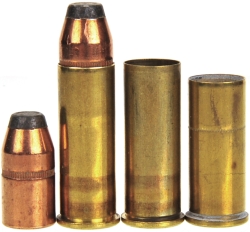
Part 1 concluded with a cartridge too long / bolt stroke too short conundrum. So I took a break, scratched my head, hickory smoked some ribs, grilled some Gouda and bacon stuffed center cut pork chops and then went on to exercise the only reasonable option that came to mind… which turns out to be the only exercise I’ve had this summer, and trimmed back the case.
Ordinarily I would have just selected a different bullet that fell within functional limits for cartridge length, however, the Sierra 300 grain is an excellent bullet for rifle applications where velocity is elevated. The lead core is 6% antimony making it a very hard alloy and the jacket is also very thick and tough; typically used for handgun hunting big and dangerous game.
The bullet probably penetrates too much for thin skinned game, like deer, at handgun velocity levels, but it may be a more accommodating for a deer hunter when fired at rifle velocity levels. Use of this long bullet also presented the opportunity to run through the process of trimming back cartridge cases, where applicable, to allow the use of longer bullets than typical.
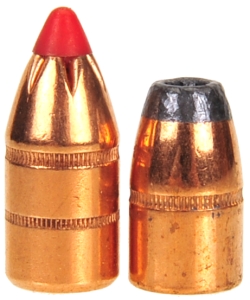 Handloaders who handload Hornady FTX bullets are familiar with a case shortening requirement. The FTX has a long ogive that sits well above the cartridge’s case mouth in comparison to standard jacketed bullets. Right, this 325 grain 45-70 FTX bullet weighs only 25 grains more than the flat nose bullet, yet the FTX it is almost 0.300″ longer in overall length and protrudes 0.150″ more above the cannelure. Casing used when loading for a lever action rifle need to be trimmed 0.065″ shorter to allow the assembled cartridge to cycle. The same applies when a 225 grain Hornady FTX is used with the 44 Magnum… however, I had none on hand to illustrate.
Handloaders who handload Hornady FTX bullets are familiar with a case shortening requirement. The FTX has a long ogive that sits well above the cartridge’s case mouth in comparison to standard jacketed bullets. Right, this 325 grain 45-70 FTX bullet weighs only 25 grains more than the flat nose bullet, yet the FTX it is almost 0.300″ longer in overall length and protrudes 0.150″ more above the cannelure. Casing used when loading for a lever action rifle need to be trimmed 0.065″ shorter to allow the assembled cartridge to cycle. The same applies when a 225 grain Hornady FTX is used with the 44 Magnum… however, I had none on hand to illustrate.
The Sierra 300 grain Sports Master 44 Magnum bullet, below right, next to a 300 grain dual cannelure Hornady, also has a long ogive that projects well ahead of the bullet’s cannelure. Subsequently, when crimped in place with standard length brass it will have a an excessively long cartridge overall length, 1.750″, and it will not cycle through the Marlin Model 1894.
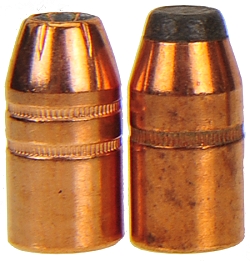
In Part I, it was noted that in 1973 the Marlin 1894 44 Magnum was modified to cycle cartridges up to a 1.710″ cartridge overall length, 0.100″ greater than the SAAMI spec, for the benefit of handloaders. Sometimes this clearance holds true, sometimes a little feed system rework is required to get the nose of a bullet on a case of this length to clear the transition from magazine to chamber. This Marlin can accommodate 1.695″ COL.
Hornady addresses the heavy bullet / overall length issue by imprinting their 300 grain bullet with two cannelures, one high on the bullet shank, that allows it to be assembled into a 1.615″ COL cartridge. That works out nicely. In order to use the Sierra 300 grain bullet, either an additional cannelure can be placed high on the bullet’s shank and the bullet seated more deeply, or the case can be reduced in length to shorten the COL.
Jut a little off the top…
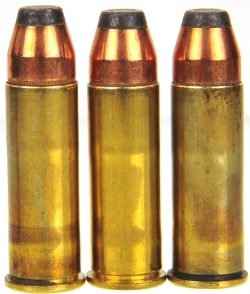
The 44 Magnum cartridge, far left, has a 1.285″ full length case, 300 grain Sierra Sports Master bullet and is assembled to 1.750″. The middle round case is trimmed to 1.250, same bullet, which yielded a 1.710″ COL, which was too long to cycle through the rifle cleanly. The cartridge, far right, was case trimmed to 1.245″ and cartridge overall length ended up as 1.695″. The latter cycled cleanly through the Marlin.
This case surgery has some predictable side effects. The first cartridge has approximately 24.0 grains of net capacity. the second has approximately 22.5 grains of net capacity and the third has approximately 21.9 grains of capacity. Published load data for the 300 grain Sierra bullet assembled to 1.750″ could not be used for the same bullet loaded to 1.695″ as the same amount of powder loaded into a smaller case volume would have increased pressure by approximately 6,000 PSI.
There were a few other factors to consider and check out before taking a whack at the case. Short cases and deep seated bullets can end with the thicker web of a cartridges case head bumping the heel of a bullet. Generally, that applies to exceptional trimming and beginning with a very short case; not even close to being an issue here. A second consideration, reduced length cases must be segregated from the general brass population as they require a different die setup. Finally, a portion of the chamber is exposed and can accumulate ejecta, gunk up the chamber and eventually interfere with standard length cartridge chambering. However, it would take a really filthy firearm and a really lazy guy who doesn’t properly maintain his firearms for that problem to develop.
And the final four… drum roll
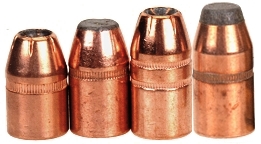
After fiddling with potential load data and getting tired playing with the power trimmer…
| Bullet | Type | Weight Grains |
Length | Seating Depth |
COL |
| Hornady HP/XTP | JHP | 240 | 0.710 | 0.360 | 1.635 |
| Speer Gold Dot | JSP | 270 | 0.775 | 0.445 | 1.615 |
| Hornady HP/XTP | JHP | 300 | 0.860 | 0.530 | 1.615 |
| Sierra FN | JSP | 300 | 0.890 | 0.430 | 1.695 |
The four bullets above represent a decent selection for 44 Magnum hunting from the lightest reasonable to the heaviest for larger tough game. As assembled cartridges they will all work with the Model 1894. Below is the raw data as collected from targets and the chronograph. I went with Hodgdon’s Lil’ Gun for all of the bullet weights. Lil’ Gun has proven to be a good powder, handling a wide variety of bullet weights and generating a bit more velocity than H110 or W296. Loads are on the high end, so I wouldn’t go right to this level or put them through a S&W Model 29.
 |
Warning: Bullet selections are specific, and loads are not valid with substitutions of different bullets of the same weight. Variations in bullet material and length will alter net case capacity, pressure and velocity results. Primer selection is specific and primer types are not interchangeable. These data represents maximum loads in our firearms and test equipment and may easily be excessive in other applications. All loads should be reduced by 5%, and developed following safe handloading practices as represented in established reloading manuals produced by component manufacturers. Presentation of these loads does not constitute a solicitation for their use, nor a recommendation.
|
|||||||||||||||||||||||||||||||||||||||||||||||||||||||||||||||||||||||||||||
|
|
||||||||||||||||||||||||||||||||||||||||||||||||||||||||||||||||||||||||||||||
Since I had to walk out to collect then, we may as well look at them….
Note worthy… Point of impact shifted quite a bit as bullet weight changed. From a bore sighted zero, 240 grain bullets shot 1/2″ high and approximately 2″ right. 270 grain shot about on. Hornady 300 grain shot 4 1/2″ low and 2 1/2″ left. Sierra 300 grains shot 5″ low and 3″ left. Of course, sighting in with the ammunition planned for a hunt solves the shifting problem, however, shuffling ammunition in the field would take considerable adjustment.
The Marlin has 1:38″ rifling. I realize that the prevailing gun forum wisdom is that the barrel should be changed to a 1:20″ twist or it won’t shoot 300 grain bullets with accuracy. Fortunately, my rifle doesn’t spend much time reading posts in gun forums and its accuracy meets all of my expectations. I always think the greater wisdom is to collect lots and lots of opinion and information from the Internet and in human discussion, then grab your ammo and firearm and head for the range or a hunt and, based upon your direct experience, arrive at your own conclusions. So why read any of this Internet stuff? It’s no different than print publications, the information may give you something new to consider.

I don’t know what is up with the 270 grain Speer. My guess, because everything else grouped in a very common fashion, is that I blew it on powder metering. Usually a flyer like this is caused by something loose and shifting on the rifle; scope, stock, shooter, but that tends to show in all groups shot with the same firearm. A single instance is usually the result of erratic velocity. Since this group scatter did not show in other loads with the same powder type, operating at similar pressure levels, I think the problem is the guy metering powder… or crimping, or seating. Unfortunately, I ran out of time before I could nail this down further, but I will reshoot on another day.
The Marlin Model 1894
I like this little gun and big cartridge. The rifle is light, skinny and it looks good. Accuracy is excellent, power is more than sufficient for deer, black bear and hogs. It even has a little kick to remind me it is a 44 Remington Magnum. Good combination.
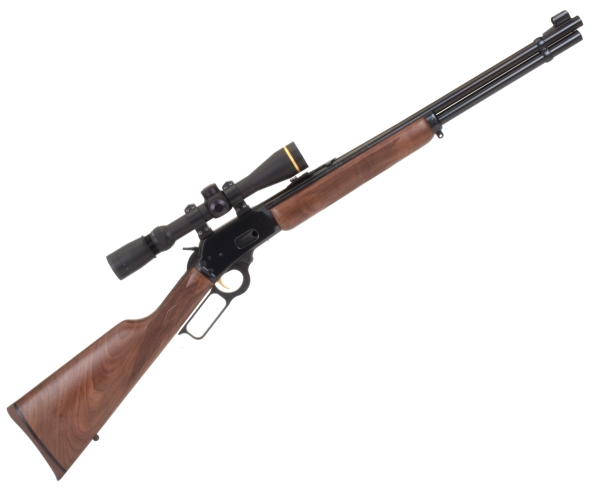
The 44 Magnum Rifle Round Part 1
The 44 Magnum Rifle Round Part 2
The 44 Magnum Rifle Round Part 3

Email Notification